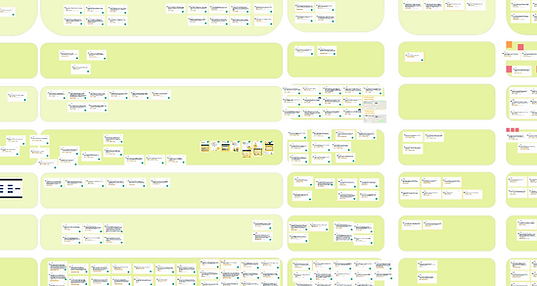Service Design
When thinking about internal processes, I understood the Service Design project as a primordial practice for the development of digital products: looking at problems from the inside to improve what impacts the user on the outside.
How it all began
We all know that internal noises can hinder the construction of user experience, from usability itself to the points of contact with operational areas. On that note, Service Design was the resource chosen to remedy the problems identified between the areas and improve processes that had operational failures as a legacy.

What was done
Our team of Product and Content Designers conducted interviews with 24 employees from 14 areas of the company to analyze the product journey. 677 insights cards were generated to identify journey's problems, from which 36 problems were found, such as unqualified leads, inefficient tools for the internal team, unnecessary manual processes, rigorous and bureaucratic credit analysis criteria, delays in signing contracts and lack of standardization in files and spreadsheets sent by the client.
From this in-depth analysis, we created the Service Blueprint, a diagram that draws connection points between the different parts of the service provided within the product framework.
The 3 most critical problems of the proposal, onboarding and fee launch stages were chosen based on what caused churn and impacted the company's profitability. In addition, we held 3 workshops with multidisciplinary teams to address the issues in depth.

Challenge 1 (Proposal Stage):
How can we develop a more attractive proposal that wins over the customer, also creating the desire to deal with CondoConta and sign the contract immediately when they receive it?
17 employees from 12 different areas participated and 45 ideas were generated. Of the simple ideas that could be implemented in the short term, without technology development, we had 29 ideas such as educational videos, legal design application, direct speech dynamics and simulator, cosen from the most voted.
Challenge 2 (Onboarding Stage):
How can we reduce customer doubts and facilitate the onboarding process as a whole?
16 employees from 7 different areas participated and 27 ideas were generated. Of the simple ideas that could be implemented in the short term, without technology development, we had 14 ideas such as playbooks, tutorial videos and gamification, chosen from the most voted.
Challenge 3 (Onboarding Stage):
How can we keep an updated registration base and reduce customer dissatisfaction when filling out manual spreadsheets?
12 employees participated drom 10 different areas and 28 ideas were generated. Of the simple ideas that could be implemented in the short term, without technology development, we had 14 ideas such as a support e-book, educational videos and communication rules, chosen from the most voted.

For each challenge, meetings were held with the product team and operations leaders to define which ideas we would prototype. All detailed prototypes were forwarded to the areas involved to prioritize and include in their roadmaps, with a constant follow-up by the product team and updating of the blueprint. In the Content Design team, we focused on auditing existing materials according to each team's priorities, creating support materials for Partners and continuing to carry out research.
The project was also shared with the entire company so that all areas involved in could consult the pain points to be resolved and act independently of the product team. As an example, a prospecting stage was not prioritized and taken to workshops, and the growth team worked in parallel on qualifying leads, which brought excellent results to the sales team.